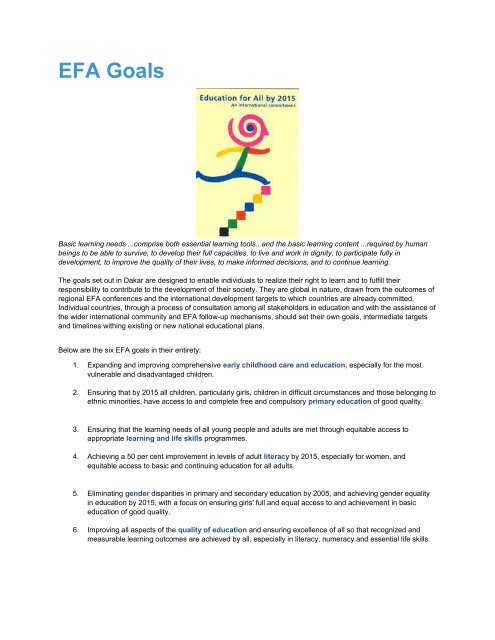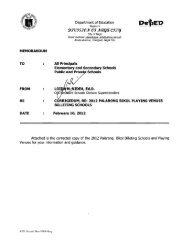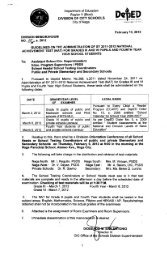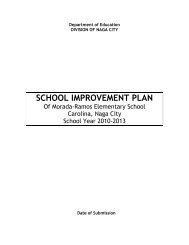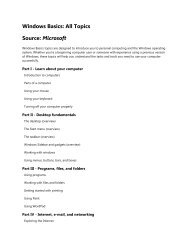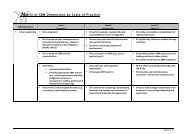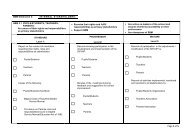EFA Goals - DepEd Naga City
EFA Goals - DepEd Naga City
EFA Goals - DepEd Naga City
Create successful ePaper yourself
Turn your PDF publications into a flip-book with our unique Google optimized e-Paper software.
<strong>EFA</strong> <strong>Goals</strong>Basic learning needs ...comprise both essential learning tools...and the basic learning content ...required by humanbeings to be able to survive, to develop their full capacities, to live and work in dignity, to participate fully indevelopment, to improve the quality of their lives, to make informed decisions, and to continue learning.The goals set out in Dakar are designed to enable individuals to realize their right to learn and to fulfill theirresponsibility to contribute to the development of their society. They are global in nature, drawn from the outcomes ofregional <strong>EFA</strong> conferences and the international development targets to which countries are already committed.Individual countries, through a process of consultation among all stakeholders in education and with the assistance ofthe wider international community and <strong>EFA</strong> follow-up mechanisms, should set their own goals, intermediate targetsand timelines withing existing or new national educational plans.Below are the six <strong>EFA</strong> goals in their entirety:1. Expanding and improving comprehensive early childhood care and education, especially for the mostvulnerable and disadvantaged children.2. Ensuring that by 2015 all children, particularly girls, children in difficult circumstances and those belonging toethnic minorities, have access to and complete free and compulsory primary education of good quality.3. Ensuring that the learning needs of all young people and adults are met through equitable access toappropriate learning and life skills programmes.4. Achieving a 50 per cent improvement in levels of adult literacy by 2015, especially for women, andequitable access to basic and continuing education for all adults.5. Eliminating gender disparities in primary and secondary education by 2005, and achieving gender equalityin education by 2015, with a focus on ensuring girls' full and equal access to and achievement in basiceducation of good quality.6. Improving all aspects of the quality of education and ensuring excellence of all so that recognized andmeasurable learning outcomes are achieved by all, especially in literacy, numeracy and essential life skills.
Education for All <strong>Goals</strong>Six internationally agreed education goals aim to meet the learning needs of all children, youth andadults by 2015.Goal 1Expanding and improving comprehensive early childhood care and education, especially for the mostvulnerable and disadvantaged children.Goal 2Ensuring that by 2015 all children, particularly girls, children in difficult circumstances and thosebelonging to ethnic minorities, have access to, and complete, free and compulsory primary education ofgood quality.Goal 3Ensuring that the learning needs of all young people and adults are met through equitable access toappropriate learning and life-skills programmes.Goal 4Achieving a 50 per cent improvement in levels of adult literacy by 2015, especially for women, andequitable access to basic and continuing education for all adults.Goal 5Eliminating gender disparities in primary and secondary education by 2005, and achieving genderequality in education by 2015, with a focus on ensuring girls’ full and equal access to and achievement inbasic education of good quality.Goal 6Improving all aspects of the quality of education and ensuring excellence of all so that recognized andmeasurable learning outcomes are achieved by all, especially in literacy, numeracy and essential lifeskills.
The six goals of Education for All (<strong>EFA</strong>) have become UNESCO’s overriding priorityin educationExpand early childhood care and educationThe goal calls for better and more possibilities to support youngchildren, and their families and communities, in all the areas wherethe child is growing – physically, emotionally, socially andintellectually.Provide free and compulsory primary education for allTherefore this goal sets the objective of seeing that all children –girls as well as boys – go to school and finish primary education.Promote learning and life skills for young people and adultsThis goal places the emphasis on the learning needs of young peopleand adults in the context of lifelong learning.Increase adult literacy by 50 per centThis goal calls for a certain level of improvement in adult literacy by2015 – it says that it should be 50 per cent better than it was in2000.Achieve gender parity by 2005, gender equality by 2015This goal calls for an equal number of girls and boys to be enrolledin primary and secondary school by 2005 – this is what genderparity means.Improve the quality of educationThis goal calls for improvement in the quality of education in all itsaspects, aiming for a situation where people can achieveexcellence.


